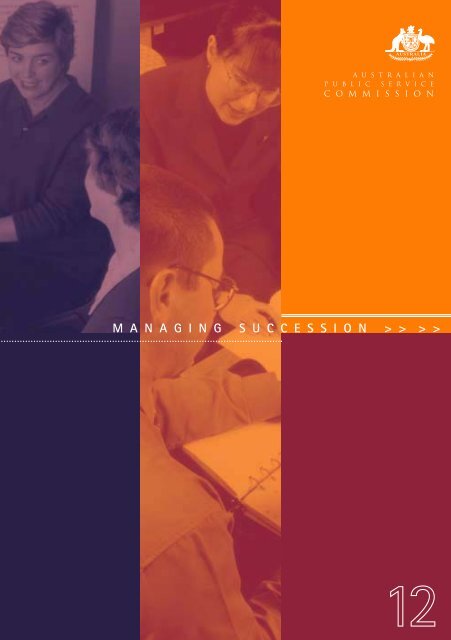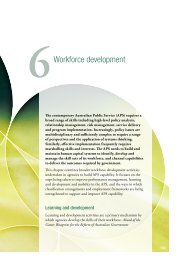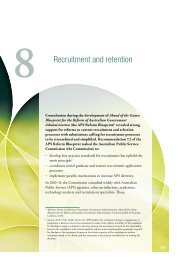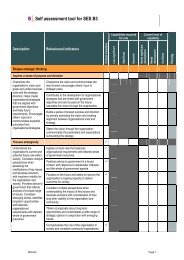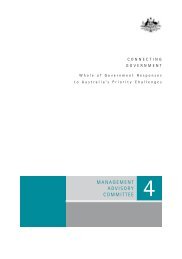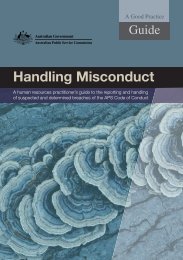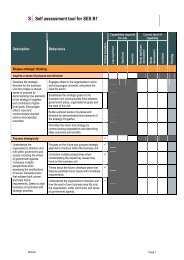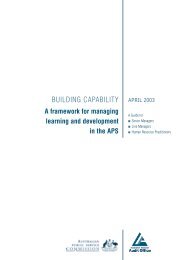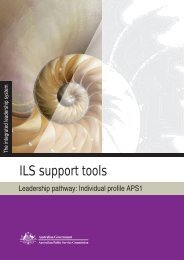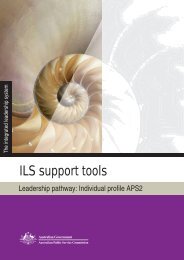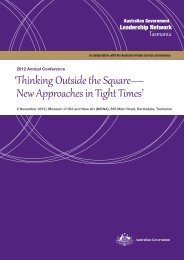Managing succession - Australian Public Service Commission
Managing succession - Australian Public Service Commission
Managing succession - Australian Public Service Commission
Create successful ePaper yourself
Turn your PDF publications into a flip-book with our unique Google optimized e-Paper software.
AUSTRALIA<br />
A U S T R A L I A N<br />
P U B L I C S E R V I C E<br />
C O M M I S S I O N<br />
M A N A G I N G S U C C E S S I O N > > > ><br />
12
Previous titles<br />
1. Values in the <strong>Australian</strong> <strong>Public</strong> <strong>Service</strong><br />
(currently available in the Values and Conduct series)<br />
2. <strong>Managing</strong> Breaches of the APS Code of Conduct<br />
(currently available in the Working with the Act series)<br />
3. Counselling for Better Work Performance<br />
(currently available in the Working Together series)<br />
4. Guidelines on Workplace Diversity<br />
(currently available in the Working Together series)<br />
5. Maintaining a Harassment-free Workplace<br />
(currently available in the Working Together series)<br />
6. Senior Executive <strong>Service</strong><br />
(currently available in the Working with the Act series)<br />
7. Recruitment of Indigenous <strong>Australian</strong>s in the <strong>Australian</strong> <strong>Public</strong><br />
<strong>Service</strong> (currently available in the Working Together series)<br />
8. Outsourcing: Human Resource Management Issues<br />
9. Delegations<br />
10. Performance Management<br />
11. Termination of Employment<br />
S E R I E S B O O K L I S T > > > >
AUSTRALIA<br />
MANAGING SUCCESSION IN THE<br />
AUSTRALIAN PUBLIC SERVICE<br />
>> >><br />
12
© Commonwealth of Australia 2003<br />
ISBN 0 642 54351 8<br />
This work is copyright. Apart from any use as permitted under the Copyright Act 1968, no part<br />
may be reproduced by any process without permission from AusInfo. Requests and enquiries<br />
concerning reproduction and rights should be addressed to the Manager, Legislative <strong>Service</strong>s,<br />
AusInfo, GPO Box 84, Canberra ACT 2601.
FOREWORD > > > ><br />
This paper reports on research undertaken by the <strong>Australian</strong> <strong>Public</strong><br />
<strong>Service</strong> <strong>Commission</strong>, and provides insight into best practice<br />
<strong>succession</strong> management in the public and private sectors.<br />
The ageing workforce, changing career expectations, and the<br />
potential for attrition of high performers with substantial<br />
experience in the <strong>Australian</strong> <strong>Public</strong> <strong>Service</strong> (APS) is a challenge to<br />
agencies to sustain performance into the future.<br />
Succession management forms a key component of workforce<br />
planning, focusing on ensuring the availability of a supply of<br />
capable staff who are ready to assume key or critical positions.<br />
It helps build organisational capacity by ensuring that vacancies<br />
can be filled from within the organisation or from partner<br />
organisations, and by improving the quality of the competition<br />
for positions.<br />
Far from being inconsistent with the merit principle, good<br />
<strong>succession</strong> management will promote the APS Values by<br />
developing staff and emphasising openness in selection processes<br />
and thereby promoting merit and equity in employment and a<br />
career-based <strong>Service</strong>.<br />
I commend this research paper to you, and encourage you to take<br />
steps to ensure the long-term capability of your agency.<br />
Andrew Podger<br />
<strong>Public</strong> <strong>Service</strong> <strong>Commission</strong>er<br />
February 2003<br />
iii >>>
CONTENTS<br />
> > > ><br />
INTRODUCTION . . . . . . . . . . . . . . . . . . . . . . . . . . . . . . . . . . . . . . . . . . . . . . . . . . . . . . . .1<br />
OVERVIEW: WHAT IS SUCCESSION MANAGEMENT? . . . . . . . . . . . . .3<br />
What does <strong>succession</strong> management involve? . . . . . . . . . . . . . . . . . . . . . . . . . . . . . . . . . . . . . .4<br />
Developing internal capability: an approach to managing <strong>succession</strong> . . . . . . . . . . . . . . . . . . .4<br />
Is there a ‘one size fits all’ model? . . . . . . . . . . . . . . . . . . . . . . . . . . . . . . . . . . . . . . . . . . . . . .6<br />
EFFECTIVENESS IN SUCCESSION MANAGEMENT:<br />
KEY PRINCIPLES . . . . . . . . . . . . . . . . . . . . . . . . . . . . . . . . . . . . . . . . . . . . . . . . . . . . . .7<br />
MANAGING SUCCESSION WITHIN THE APS<br />
VALUES FRAMEWORK . . . . . . . . . . . . . . . . . . . . . . . . . . . . . . . . . . . . . . . . . . . . . . .11<br />
A spotlight on merit . . . . . . . . . . . . . . . . . . . . . . . . . . . . . . . . . . . . . . . . . . . . . . . . . . . . . . . . .12<br />
APPROACHING SUCCESSION MANAGEMENT: A GUIDE . . . . . . . . .15<br />
Designing the process . . . . . . . . . . . . . . . . . . . . . . . . . . . . . . . . . . . . . . . . . . . . . . . . . . . . . . .15<br />
Ensuring strategic integration . . . . . . . . . . . . . . . . . . . . . . . . . . . . . . . . . . . . . . . . . . . . . . . . .16<br />
Assessing the current situation . . . . . . . . . . . . . . . . . . . . . . . . . . . . . . . . . . . . . . . . . . . . . . . .16<br />
Identifying and assessing potential . . . . . . . . . . . . . . . . . . . . . . . . . . . . . . . . . . . . . . . . . . . . .17<br />
Implementation: planning and undertaking development . . . . . . . . . . . . . . . . . . . . . . . . . . . .18<br />
Evaluation: some considerations . . . . . . . . . . . . . . . . . . . . . . . . . . . . . . . . . . . . . . . . . . . . . . .19<br />
ENDNOTES . . . . . . . . . . . . . . . . . . . . . . . . . . . . . . . . . . . . . . . . . . . . . . . . . . . . . . . . . . . .21
INTRODUCTION<br />
> > > ><br />
In an environment of rapid change there are significant concerns<br />
about the need ‘to ensure organisational sustainability, flexibility<br />
and responsiveness’ 1 . Issues such as an ageing of the workforce,<br />
the relatively short tenure of young graduates in some areas of<br />
specialisation, the associated potential for attrition from the<br />
<strong>Australian</strong> <strong>Public</strong> <strong>Service</strong> (APS) to increase substantially 2 , and effects<br />
of the downsizing and outsourcing of expertise, challenge agencies<br />
to ensure they have the capacity to sustain performance and<br />
responsiveness in the future. It is within this context that APS<br />
organisations are looking with increased scrutiny at the need to<br />
manage employee <strong>succession</strong> effectively to ensure that they have<br />
the future leadership, management and technical capacity to deliver<br />
government expectations. Succession management is a component<br />
of workforce planning, which considers aggregate and future<br />
organisational capability and staffing needs, and strategies to<br />
ensure that these can be fulfilled. Succession management focuses<br />
on identified critical roles and seeks to ensure there is current and<br />
future capacity for these to be filled with effective staff.<br />
Agencies are considering <strong>succession</strong> management within the<br />
context of the APS Values and the accountability frameworks<br />
which guide the operation of the APS. In particular, <strong>succession</strong><br />
management must operate alongside openness in selection<br />
processes, a fundamental consideration in terms of the APS Values<br />
regarding merit and equity, and Agency Heads are focusing in<br />
particular on very senior levels of their organisations, and on<br />
agencies within portfolios. They are also emphasising the need to<br />
engage in development activity to ensure a flow of candidates to<br />
fill senior roles.<br />
1 >>>
The concept of <strong>succession</strong> management is discussed in more detail in this paper. The objectives<br />
of this paper are to:<br />
• introduce the concept of <strong>succession</strong> management<br />
• identify key principles for effectiveness in <strong>succession</strong> management<br />
• consider how <strong>succession</strong> management can be implemented within the APS to give<br />
practical effect to the APS Values<br />
• identify practical <strong>succession</strong> management initiatives which have been effective<br />
• provide broad guidance on approaches to this issue.<br />
The views of a range of small and large public sector agencies and networks, including agencies<br />
employing technical specialists and professional staff, are included in this paper as examples<br />
of <strong>succession</strong> management practices in the public sector context.<br />
OVERVIEW: WHAT IS<br />
SUCCESSION MANAGEMENT?<br />
> > > ><br />
Succession management is a strategic, systematic and deliberate<br />
activity to ensure an organisation’s future capability to fill<br />
vacancies, without ‘patronage or favouritism... [and] within the<br />
Framework of the merit principle and the APS Values.’ 3 It specifically<br />
focuses on ensuring the availability and sustainability of a supply<br />
of capable staff who are ready to assume key or critical roles, if<br />
selected through normal APS competitive selection processes.<br />
Succession management may include some reference to external<br />
recruitment markets, lateral recruitment from other APS<br />
organisations, and in some cases, involve the short-term<br />
‘purchase’ of skills. A significant emphasis will be on the<br />
development of internal capability, which can also contribute to<br />
organisational readiness when contingencies occur.<br />
The critical roles in question may be at senior levels within<br />
an agency, or at other levels requiring particular technical or<br />
management capabilities that are crucial to achieving the<br />
organisation's outcomes. (NB: For the purposes of this discussion<br />
and for ease, however, these will all be described as leadership<br />
roles, regardless of organisational level or particular duties.)<br />
If these roles are unfilled, or filled with staff without the required<br />
levels of capability, an agency may not be able to deliver the<br />
required outputs that contribute to achieving the desired<br />
outcomes of the government of the day. Such roles may exist<br />
currently or they may emerge over time as the organisation<br />
implements strategic decisions and directions.<br />
Succession management is not an end in itself, or an add-on<br />
activity. It forms a subset of broader agency approaches to<br />
workforce planning which seek to ensure in general that the<br />
right people are in the right place at the right time to achieve<br />
successful business outcomes 4 . Like workforce planning,<br />
<strong>succession</strong> management involves questions about the changing<br />
nature of work and the sorts of roles that are likely to emerge<br />
rather than focusing solely on today’s roles which may not be<br />
required in the future. The focus of <strong>succession</strong> management is to<br />
ensure a flow of candidates who have the skills, knowledge and<br />
attributes to compete for vacancies in critical roles when they<br />
arise 5 , rather than looking at the aggregate staffing needs for<br />
3 >>>
entire job families across the organisation. Other strategies that contribute to integrated<br />
workforce planning include undertaking robust and comprehensive demographic analysis, and<br />
the implementation of initiatives such as targeted recruitment programs, retention strategies,<br />
performance management strategies, knowledge management systems, and learning and<br />
development interventions.<br />
Succession management strategies, which focus on developing employee capability, enable<br />
organisations to respond to change.<br />
WHAT DOES SUCCESSION MANAGEMENT INVOLVE?<br />
Succession management involves a planned and systematic effort to project and respond<br />
to leadership requirements throughout the organisation now and in the future. Several steps<br />
are involved:<br />
• Identify critical roles within the organisation and develop a clear understanding of the<br />
capabilities required for effectiveness and high performance in those roles.<br />
• Undertake a risk assessment by forecasting potential shortages and surpluses of potential<br />
candidates for those roles 6 . This step should draw on agency demographic analysis and<br />
may include analysis of recruitment and retention patterns, projected skills requirements<br />
and the need for specific jobs: it could also include an analysis of market factors such as<br />
where skills could be sourced externally, as well assessing where internal development<br />
resources should be focused.<br />
• Identify people who could potentially fill and perform highly in such roles 7 . (NB: internally,<br />
those people may already be apparent and waiting for an opportunity to apply for a more<br />
demanding role, or, the organisation may need to take steps to identify them; they may<br />
also need to refer to external sources to determine potential availability of staff).<br />
• Develop the required capabilities in those people already within the organisation through<br />
a program of learning experiences, planned collaboratively by the organisation working<br />
with the individual 8 . This development may be accelerated if necessary to ensure a ready<br />
supply of staff for future role requirements, and/or undertaken as part of the agency’s<br />
established performance management framework. (NB: If people already have the<br />
required capabilities and are waiting to apply for suitable opportunities, or they are<br />
already in a highly challenging and designated developmental role, their development<br />
would not need to be accelerated. The nature of such developmental activity is expanded<br />
in a later section on implementation.)<br />
DEVELOPING INTERNAL CAPABILITY:<br />
AN APPROACH TO MANAGING SUCCESSION<br />
The APS is an open system, where reasonable opportunity is provided to eligible members of<br />
the <strong>Australian</strong> community to apply for APS employment 9 . Strategies mentioned earlier, such as<br />
reference to external sources of expertise are useful mechanisms for refreshing and renewing<br />
the leadership base in the organisation, and introducing new and challenging ideas.<br />
However, sole reliance on a strategy to attract employees from the external market is risky and<br />
expensive: seeking responses from ad hoc advertisements of vacancies is not a completely<br />
reliable substitute for developing future leaders from within, and building the capabilities of<br />
ensuing generations of employees.<br />
One complementary strategy is to consider identifying or developing employees who<br />
demonstrate leadership potential, and to accelerate or intensify their development to ensure<br />
the organisation’s capacity to respond to immediate gaps and to meet future needs. Such<br />
targeted development should operate alongside more broad-based development of employees<br />
linked to learning and development plans and based around established performance<br />
management processes.<br />
Building a supply of capable staff:<br />
• adds to organisational certainty and sustainability<br />
• provides a mechanism for agencies to build 'bench strength', that is, a robust field or fields<br />
for any number of roles by creating a supply of employees with needed capabilities,<br />
flexibilities and skill sets<br />
• provides organisations with an opportunity to incorporate diversity objectives into<br />
leadership development strategies by encouraging interest, within specified parameters,<br />
from a wide range of employees for accelerated development<br />
• provides a mechanism to give strongly skilled employees an indicator of possible future<br />
advancement, a factor which has been identified as a key variable in the retention of<br />
those individuals identified as having exceptional potential 10 .<br />
However, expectations regarding promotion in the APS must be carefully managed if the<br />
concept of ‘bench strength’ is to be introduced. Promotees for any position may come from a<br />
wide range of sources, including those with demonstrated/identified potential, other employees<br />
from within or outside the area or indeed from outside the organisation. There is no<br />
presumption of upward movement or implicit guarantee of promotion 11 from undertaking a<br />
particular developmental activity. In addition, employees not initially considered for<br />
accelerated development activity can be subsequently considered, based on assessments of<br />
performance and potential. For example, this might include those whose performance becomes<br />
exceptional later in their career, as well as late entrants to the APS. No one is permanently<br />
excluded from being considered for accelerated development opportunities, given that such<br />
opportunities may be offered subject to demonstrated performance, assessed potential and<br />
demonstrated progress against the commitments in the individual's development plan: these<br />
are reviewed regularly and change over time, and it is important to avoid stereotyping or<br />
‘pigeonholing’ employees. Assessments of performance and potential are based on snapshots<br />
taken from the agency’s performance management framework as well as ongoing discussions.<br />
The appropriateness of access to continuing accelerated development activity in relation to<br />
any individual may change according to their particular circumstances at any given time,<br />
for example, on the basis of ongoing quality of performance, life circumstances and<br />
personal preferences.<br />
5 >>>
IS THERE A ‘ONE SIZE FITS ALL’ MODEL?<br />
Different approaches to <strong>succession</strong> management, and to the types of opportunities provided for<br />
employees to gain particular skills, knowledge and capabilities, may be taken depending on the<br />
size of the organisation or the position under consideration. For example, agencies may target<br />
individual roles, particular professional expertise or more general classifications. Most agencies<br />
consulted focus <strong>succession</strong> management efforts on senior leadership roles in the first instance,<br />
with a view to extending the process into other critical roles at lower classification levels later.<br />
Some agencies have identified less senior critical roles first such as information technology<br />
specialists, statistical analysts, front-line processors. In some agencies, <strong>succession</strong><br />
management focuses on professional roles, where expertise is not readily available outside the<br />
organisation and is not likely to be a focus for development anywhere outside the organisation.<br />
The development for senior leadership roles may focus on ensuring that candidates experience<br />
a wide range of challenging assignments to develop their capabilities for any number of<br />
unspecified roles. Work placements tailored to individual learning needs, along with training<br />
programs and executive coaching all figure strongly in agency approaches to date. For front-line<br />
supervisory roles, the focus may be on multi-skilling a number of candidates to ensure that there<br />
are contingencies in place should a position become vacant. For specialist roles, the focus may<br />
be on ongoing and rigorous development of professional expertise as well as broader<br />
development of management and leadership capabilities. Agencies stressed the importance of<br />
transferring highly specialised professional expertise to others within the organisation where it<br />
is known the current incumbent is to leave the organisation. There is no option to ‘buy in’ that<br />
expertise. Those agencies consulted use a range of options to ensure the transfer of expertise,<br />
including shadowing. Agencies are also investigating administrative arrangements that would<br />
allow ongoing access to an individual’s professional expertise after that individual retires.<br />
Some organisations will choose to develop entire cohorts or generations of staff through<br />
leadership and management development and other training initiatives, rather than focusing<br />
specifically on those with demonstrated leadership potential. A strategy of using general<br />
training rather than investing resources in accelerated leadership development may also be<br />
more appropriate for smaller organisations or those organisations with a tightly constrained<br />
training budget. However, even with a limited budget or limited resources, the small agencies<br />
consulted have been able to target critical roles and offer ‘high potential’ staff the opportunity<br />
for further individualised development. In one agency, this involves internal re-assignment to<br />
develop skills for critical roles (at minimal cost to the organisation); in another it involves<br />
working with a coach and accessing accelerated leadership development through external<br />
training programs.<br />
EFFECTIVENESS IN SUCCESSION<br />
MANAGEMENT: KEY PRINCIPLES<br />
> > > ><br />
There are a number of general principles which contribute to<br />
effective <strong>succession</strong> management.<br />
1. Top leaders in the organisation must be actively committed<br />
to and involved in the process: they convey that <strong>succession</strong><br />
management is a key organisational priority and one which<br />
requires collaboration across the organisation.<br />
‘Leaders also have a central role to play in fostering and<br />
developing leadership skills across the <strong>Service</strong>, and in<br />
managing <strong>succession</strong> processes, not only in their own<br />
agencies but for the APS as a whole. This challenge is an<br />
enduring one, given that leaders must drive an ongoing and<br />
iterative process of building and renewing their own<br />
organisation's capability, as well as contributing to<br />
collaborative efforts across the APS. This includes fostering a<br />
future generation of leaders.’ 12<br />
All but one of the agencies consulted have executive<br />
commitment and involvement in the <strong>succession</strong> management<br />
process. Agencies see this as crucial to the success of the<br />
<strong>succession</strong> management in the organisation. The level of<br />
success is commensurate with the level of executive<br />
commitment. One agency commented that the <strong>succession</strong><br />
management process is operating without executive support.<br />
This has limited the options to develop those identified as<br />
having high potential and has impacted significantly on the<br />
available budget.<br />
2. Succession management should be an integral component<br />
of the organisation's business and workforce planning<br />
framework linked to current and evolving organisational<br />
needs. It should be based on a clearly outlined business case 13<br />
(which may include analysis of demographic and trend data,<br />
forecasted attrition rates, availability of external labour, and<br />
forecast of supply and demand for critical skill sets) and<br />
linked to existing recruitment, performance management,<br />
learning and development, leadership development and<br />
career planning initiatives.<br />
7 >>>
Most agencies consulted have implemented, or intend to implement, <strong>succession</strong><br />
management within the context of workforce planning. Succession management is seen<br />
as a means of meeting future business needs in particular organisational areas and is one<br />
of a range of strategies within the broader workforce planning framework.<br />
3. A <strong>succession</strong> culture should be developed at all levels, not just at the top 14 , with shared<br />
responsibility for <strong>succession</strong> management across the organisation.<br />
Agencies with top-level commitment report acceptance of <strong>succession</strong> management<br />
throughout the organisation and active involvement at many levels. One agency<br />
commented that executive support is so visible that a <strong>succession</strong> management culture has<br />
permeated through to the core of the organisation.<br />
4. Implementation strategies should be developed with clear timeframes and periodic<br />
evaluation built into the process from the design phase.<br />
5. Succession management should focus on identifying a robust field of potential candidates<br />
for leadership roles: it does not involve the development of lists or 'queues' for promotion,<br />
which would conflict with the merit Value.<br />
Most agencies have very clear criteria to identify potential candidates for leadership roles.<br />
While these candidates may receive considerable benefits in the form of accelerated<br />
development options, agencies expect ongoing high performance in return. It is not a oneway<br />
street.<br />
6. Succession management processes should be relatively simple and flexible.<br />
7. The process should be open across organisational levels. The career aspirations, values and<br />
preferences of employees, who are given the opportunity to express interest in pursuing<br />
leadership roles 15 , should be taken into account, as well as the needs of the organisation.<br />
• The performance management process forms a starting point for considering the<br />
performance and potential of all employees.<br />
• While the process should be communicated openly to employees, confidentiality in<br />
relation to details about specific individuals should be maintained 16 .<br />
• Individuals and managers should discuss performance, potential and development<br />
and contribute constructively to the implementation of development plans 17 .<br />
Most agencies commented that communication is essential to gain commitment to<br />
<strong>succession</strong> management processes. Many agencies have used the performance<br />
management process as an indicator of high performance and potential for leadership<br />
roles; however, it is not the sole determinant.<br />
8. The <strong>succession</strong> management process should feature the use of capability templates, rather<br />
than developing people for specific, current job requirements. Capabilities enable<br />
organisations to close the gap between strategic intent and current performance through<br />
guiding learning and development strategies, providing the basis for identification of<br />
potential and individual development plans 18 , and integration with other processes such<br />
as selection and performance assessment 19 . To ensure as much objectivity as possible, a<br />
ange of measures should be used to assess performance and potential based on the<br />
defined capabilities (note: this is discussed in more detail in a later section on assessing<br />
potential). An example of a capability template relating to senior executives is the Senior<br />
Executive Leadership Capability Framework.<br />
Most agencies consulted have had capability templates in place for some time and have<br />
used, or intend to use, these as a basis for benchmarking the skills required for critical<br />
roles and guiding learning and development for those individuals identified as having<br />
potential. One agency noted that even very broad capability templates are useful in the<br />
<strong>succession</strong> management context. However, the lack of detailed capability templates would<br />
not impede effective <strong>succession</strong> management processes.<br />
9. Development should focus particularly on challenging experiences 20 , or 'stretch'<br />
assignments that take people out of their comfort zone to develop new skills. These skills<br />
may include:<br />
• adapting to the styles and standards of a diverse array of managers<br />
• building an effective team from scratch<br />
• working with people or situations not previously encountered<br />
• being placed in high-stake, ambiguous or difficult situations<br />
• leading a remote team<br />
• working at a personal disadvantage (i.e. having the 'wrong' functional background)<br />
• dealing with or leading significant change 21 .<br />
It is important to note that there is a need to accelerate people’s experience and not<br />
just formal qualifications in developing their capability. Therefore, their development<br />
needs should match work-based opportunities rather than merely emphasising formal<br />
course outlines.<br />
Some agencies have used ‘stretch’ assignments such as adapting to the styles and<br />
standards of a diverse array of managers. Agencies also noted that while the focus is on<br />
individual development, this must be balanced with the needs of the organisation.<br />
10. The approach to <strong>succession</strong> planning must be in accordance with the APS Values.<br />
This point will be discussed in more detail in the next section.<br />
9 >>>
MANAGING SUCCESSION WITHIN<br />
THE APS VALUES FRAMEWORK<br />
> > > ><br />
The APS Values that guide the performance of the APS in turn<br />
guide the implementation of <strong>succession</strong> management. While the<br />
Values are an integrated package outlining collectively the ethos<br />
of and expectations on the APS, there are a number of specific<br />
Values which are pertinent to effective <strong>succession</strong> management in<br />
the APS. These are outlined in more detail in the <strong>Public</strong> <strong>Service</strong><br />
<strong>Commission</strong>er’s Directions 22 , and the APS <strong>Commission</strong>’s i Values in<br />
the <strong>Australian</strong> <strong>Public</strong> <strong>Service</strong> 23 . They include the need to ensure:<br />
• an apolitical public service, where there is a clear prohibition<br />
on patronage and favouritism, and which is strongly<br />
committed to excellence and professionalism<br />
• a public service in which employment decisions are based<br />
on merit<br />
— where decisions about engagement and promotion are<br />
based on an assessment of relative suitability of the<br />
candidates for the duties and relative capacity to<br />
achieve the outcomes related to the duties, and workrelated<br />
qualities such as skills, abilities, relevant<br />
personal qualities, demonstrated potential for further<br />
development and ability to contribute to team<br />
performance<br />
— in respect of other employment decisions including<br />
performance management and provision of development<br />
opportunities, the assessment is made based on the<br />
relationship between each person's relevant workrelated<br />
qualities and those required for effective and<br />
efficient organisational performance<br />
• a public service which utilises diversity, recognising that a<br />
diverse workforce is a source of new ideas and ways of<br />
working, and which can lead to improved quality, and more<br />
innovative policy advice and service delivery<br />
i<br />
The <strong>Public</strong> <strong>Service</strong> and Merit Protection <strong>Commission</strong> was formally re-titled the<br />
<strong>Australian</strong> <strong>Public</strong> <strong>Service</strong> <strong>Commission</strong> in June 2002.<br />
11 >>>
• an openly accountable public service, which can demonstrate and account for an<br />
effective, efficient and ethical use of resources<br />
• a public service which is responsive to government, with a culture that supports the<br />
provision of frank, honest, comprehensive, accurate, timely and forward-looking advice<br />
• a public service with leadership of the highest quality, based on clearly defined<br />
capabilities as the basis for development and performance management<br />
• a public service which promotes equity, and in which decisions and processes in relation<br />
to employment matters are transparent, embody equity and procedural fairness principles,<br />
and maintain appropriate confidentiality<br />
• a public service which is focused on managing performance and achieving results<br />
• a career-based service, where consultation, communication and the sharing of knowledge<br />
between agencies contribute to the maintenance of cohesive and effective government,<br />
and where development opportunities which support the retention of knowledge of<br />
government administration and service delivery within the APS are provided.<br />
Given the requirements of the <strong>Public</strong> <strong>Service</strong> Act 1999 for Agency Heads to incorporate<br />
and uphold the APS Values in all decisions and activities, these highlighted issues must be<br />
taken into account, as they relate to both the process and outcomes of any approach to<br />
<strong>succession</strong> management.<br />
A SPOTLIGHT ON MERIT<br />
The merit Value is fundamental to the nature of public service, as a guiding principle and as a<br />
process requirement for staffing decisions. In relation to engagement and promotion, this<br />
means that competitive selection processes must be carried out regardless of the existence of<br />
a supply of capable people. Therefore <strong>succession</strong> management practices should target<br />
developmental outcomes, not those relating to selections or promotions.<br />
Selection decisions must meet the criteria for merit-based decisions as outlined in the <strong>Public</strong><br />
<strong>Service</strong> Act 1999. These criteria are that:<br />
• an assessment is made of the relative suitability of the candidates for the duties, using a<br />
competitive selection process<br />
• the assessment is based on the relationship between the candidates' work-related<br />
qualities and the work-related qualities genuinely required for the duties<br />
• the assessment focuses on the relative capacity of the candidates to achieve outcomes<br />
related to the duties<br />
• the assessment is the primary consideration in making the decision 24<br />
In relation to non-selection employment decisions, such as the allocation of training and<br />
development opportunities, the merit Value requires an assessment of the person's workrelated<br />
qualities and the work-related qualities required for efficient and effective<br />
organisational performance 25 . In addition, it requires that, in the temporary assignment of APS<br />
employees to duties at a higher classification, a number of specified matters must be taken into<br />
account. These include:<br />
• the efficiency of the employee<br />
• the relative importance to the agency of the duties<br />
• the length of the temporary assignment<br />
• expected cost of the temporary assignment<br />
• the need for APS employees to be given the opportunity to gain the experience in<br />
performing duties at a higher classification 26 .<br />
Therefore <strong>succession</strong> management processes cannot provide absolute or ‘fait accompli’<br />
decisions regarding filling vacancies. Actual engagement and promotion decisions are made as<br />
the need arises. Candidates may choose to include information regarding their own<br />
performance or developmental opportunities they have undertaken in their claims against the<br />
selection criteria. However, selection criteria cannot specify or require participation in intensive<br />
or accelerated development activity as part of the <strong>succession</strong> management process, given that<br />
candidates may come from anywhere within or from outside the organisation.<br />
13 >>>
APPROACHING SUCCESSION<br />
MANAGEMENT: A GUIDE<br />
> > > ><br />
An organisation’s approach to <strong>succession</strong> management will<br />
influence perceptions of the system's effectiveness 27 . For example,<br />
the process must be conducted in accordance with the APS Values<br />
so it is not perceived as a 'tap on the shoulder' system 28 .<br />
No single or linear approach is suggested, given any approach<br />
taken must be relevant to the agency's context and needs.<br />
Although every agency will need to consider those circumstances<br />
relevant to their own organisation to determine appropriate<br />
<strong>succession</strong> management policies and processes, the following may<br />
be considered.<br />
Key steps may include:<br />
• designing the process<br />
• ensuring strategic integration<br />
• assessing the current situation<br />
• identifying and assessing high potential<br />
• implementation: planning and undertaking development<br />
• evaluation: some considerations<br />
Each parameter is discussed in the following sections. The sections<br />
aim to provide a number of key questions to consider when<br />
designing and implementing <strong>succession</strong> management.<br />
DESIGNING THE PROCESS<br />
Questions to consider include:<br />
• Have you defined a business case for <strong>succession</strong> management?<br />
Do you have the prospective leadership strength required<br />
within the organisation?<br />
• Is the process ‘owned’ by senior executives and supported by<br />
line managers?<br />
• Have you considered how data arising from the process will<br />
be managed and whether technology will be used to support<br />
the program? Consider the extent to which the human<br />
resources area will manage the process.<br />
• Have you ensured the process is transparent and considered<br />
the level of detail at which the <strong>succession</strong> management<br />
15 >>>
approach will be communicated across the organisation (being careful to maintain<br />
confidentiality of individual details)?<br />
• Have you built feedback systems to staff into the process? 29 . These might include<br />
communicating the process in general terms as well as feeding back specific information<br />
to individual employees as appropriate.<br />
• Does the approach focus on the strategic development of capabilities?<br />
• Are the outcomes of the process measurable over time?<br />
• How will you evaluate the approach in terms of organisational impact?<br />
ENSURING STRATEGIC INTEGRATION<br />
From the business and workforce planning framework, identify the critical roles to<br />
organisation's success as well as those likely to emerge as critical over the medium to longterm.<br />
Consider the agency’s demographics and implications of changing demographics on<br />
the supply of leadership candidates.<br />
Questions to consider include:<br />
• Is the approach aligned and integrated with other human resource processes?<br />
For example:<br />
— Are the identified capabilities incorporated into development planning?<br />
— Is the process integrated with the performance management system?<br />
— Have you addressed the development needs of managers who will facilitate the<br />
process and coach individuals?<br />
• What are the few distinctive leadership capabilities that will allow the organisation to be<br />
more effective than its (potential) competitors? Which ones are different from today?<br />
Incorporate future business needs, critical success factors 30 , values, strategies and<br />
expected challenges into this analysis.<br />
• In taking a medium to long-term view, is the <strong>succession</strong> management process<br />
commencing at least one to two levels below the target roles to build the required<br />
capability? 31 That is, are you looking at future generations of leaders and not just current<br />
‘feeder groups’ (if they exist) to key roles?<br />
ASSESSING THE CURRENT SITUATION<br />
Perform a risk assessment of potential departures from existing critical roles.<br />
Draw on a demographic analysis flowing from the broader workforce planning framework.<br />
Project future staffing requirements in critical roles, looking at internal and external factors<br />
(including recruitment and retention patterns) and identify worst case scenarios. From this,<br />
determine the extent of any pending leadership shortage by projecting requirements, internal<br />
mobility and attrition over the next five years i.e. consider the current 'bench strength' 32 .<br />
Analyse the gap between current capability for key roles and future requirements, and identify<br />
strategies for closing the gap 33 . Strategies could include, for example, internal capability<br />
development, external recruitment to target particular immediate skills gaps, or special<br />
programs to recruit and develop specialists. The cost-benefit considerations of these strategies<br />
would need to be assessed.<br />
IDENTIFYING AND ASSESSING POTENTIAL<br />
Clarify responsibility for identifying and assessing potential. Most performance management<br />
systems focus on discussions between supervisors and their staff about what performance is<br />
expected and how the staff is performing. Succession management, like career management,<br />
is not always best handled by immediate supervisors. The question ‘What’s my future?’ requires<br />
consideration by the supervisor’s supervisor, or even more senior management. Effective<br />
<strong>succession</strong> management requires systematic involvement by supervisors throughout the<br />
performance management system.<br />
Define what 'high potential' means within the agency context and within the context of the<br />
identified critical organisational roles (for example, the skills, knowledge and personal<br />
attributes necessary for high performance).<br />
Focus on accurate identification. In order to minimise subjectivity as much as possible and to<br />
ensure a thorough approach, use multiple ways to assess potential and to identify employees<br />
who could potentially fill the identified roles. Use the performance management system as a<br />
starting point for reviewing performance, potential and development needs. Assessments<br />
should be comprehensive and evidence-based.<br />
Relevant information could include:<br />
• biographical data<br />
• current performance<br />
• observed behaviour<br />
• adaptability<br />
• 360° feedback and formal appraisal outcomes<br />
• interviews to determine career preferences 34 and self-perceptions<br />
• assessment of likelihood of staying with the agency 35<br />
• behavioural interviews to determine past performance in challenging situations<br />
• views of a range of senior managers performance and the relative value of certain<br />
characteristics 36 , (this could include the views of the manager-once-removed where this<br />
system is in place in the agency or a senior level review body)<br />
• psychometric testing or other external assessment tools ii .<br />
ii<br />
External tests should be interpreted with caution, given that they may not indicate where people have learnt to<br />
compensate for ‘weaknesses’: they may be more useful in development planning rather than deciding who is<br />
offered accelerated development opportunity (Corporate Leadership Council 2001, ‘Overcoming Leadership<br />
Shortages with Succession Planning’, December, p5.)<br />
17 >>>
If it is congruent with the overall approach taken by the agency, consider providing individuals<br />
with opportunities to self-nominate and to express an interest in pursuing leadership roles<br />
based on their personal preferences and objectives; they can then be assessed according to the<br />
information parameters identified above . In order to contribute to the achievement of diversity<br />
goals, agencies could also encourage expressions of interest from a diverse range of employees.<br />
IMPLEMENTATION: PLANNING AND<br />
UNDERTAKING DEVELOPMENT<br />
The types of roles or experiences which may be offered as accelerated development<br />
opportunities, targeted against future business needs rather than specific jobs 38 ; incorporate<br />
exposure to a range of challenging experiences as a key element.<br />
Consider whether to designate particular sets of duties as 'development roles' within the<br />
organisation 39 , given that fewer levels and broader spans of control make it harder to arrange<br />
developmental assignments for people with high potential.<br />
A further issue to consider is whether to use a ‘co-manager’ strategy to ease older managers<br />
into retirement while preparing new leaders, to contribute to the transfer of knowledge and<br />
judgement.<br />
Establish individually tailored development plans. Development plans can be based on results<br />
from 360° feedback or the results from a development centre or other diagnostic tool, and can<br />
incorporate factors such as individual capability requirements, anticipated role challenges,<br />
required organisational knowledge and understanding, and individual factors 40 .<br />
In <strong>succession</strong> management, development plans usually include:<br />
• challenging job-based experiences selected by senior leaders as a development strategy<br />
(including job rotation, special assignments and cross-functional involvement including<br />
special projects or task forces)<br />
• exposure to the strategic agenda and to senior officials of the organisation 41<br />
• well targeted training (such as executive development programs or formal skills training<br />
where appropriate)<br />
• self-development strategies<br />
• use of senior mentors<br />
INCORPORATE OPPORTUNITIES FOR FEEDBACK<br />
AND REGULAR REVIEW.<br />
Clarify respective responsibilities. The organisation should identify the sought after capabilities,<br />
be transparent and consistent in implementing the performance management system, provide<br />
access to developmental assignments, and provide guidance and feedback. Individuals are<br />
responsible for their career and accountable for meeting developmental objectives and gaining<br />
and demonstrating new capabilities. It is important to note that while agency and manager<br />
support and involvement are critical to successful implementation of a development plan, the<br />
individual must take ultimate responsibility for meeting developmental goals and maintaining<br />
the quality of their performance.<br />
Another issue to consider is that development plans are often devised but not implemented.<br />
An alternative approach may be for the individual to create a list of development priorities in<br />
conjunction with their manager (and manager’s manager) and mentor and make it the subject<br />
of regular review.<br />
Identify how candidates will be held accountable for their development. Consider how often to<br />
review and follow-up on development plans and whether reward structures are aligned with<br />
progress in meeting developmental goals. Consider whether those employees who have been<br />
given access to intensive development opportunities will be offered continued access if their<br />
performance is not maintained in the short term: will they be offered the most challenging<br />
assignments if performance is marginal in the current performance cycle, even though they are<br />
undertaking development activity and possibly facing a steep learning curve?<br />
EVALUATION: SOME CONSIDERATIONS<br />
Establish clear timeframes for implementing and evaluating of the approach 42 and its<br />
outcomes. These issues need to be considered up-front by both the organisation and the<br />
individual(s) concerned. For the agency, evaluation of outcomes could be made in terms of<br />
whether organisational risk has been reduced or minimised. For the individual, this could<br />
include self-assessment about the degree of capability development and demonstrated<br />
changes in performance and behaviour in the workplace.<br />
Monitor the <strong>succession</strong> management system itself—periodic evaluation at this level could include<br />
assessing progress on individual development plans, the degree of involvement of current leaders<br />
or senior executives and the proportion of internal to external appointments. Informal reviews<br />
could be scheduled quarterly rather than relying on a large-scale annual process.<br />
Further issues include:<br />
• Consider whether staff with high potential will be categorised in terms of ‘readiness to<br />
assume’ 43 . For example, ready now/ready one year/requires additional development outside<br />
of current position before suitable for consideration, keeping in mind the need to avoid<br />
suggesting an ‘order of merit’ or overly close tracking of individuals which could be<br />
construed as favouritism. This should not involve comparison of individuals against each<br />
other: given the developmental focus, individual capabilities should be benchmarked<br />
against established templates, not against the capabilities of other individuals. Note that<br />
if staff are ready now in terms of demonstrated capability, retention strategies may need<br />
to be devised for them in the absence of forthcoming opportunities.<br />
• Consider the extent to which ‘bench strength’ will be formally tracked. A number of<br />
profiled companies 44 only do this for very senior people. Possible data to track for other<br />
critical roles includes: the number of employees with high potential, the number of new<br />
employees with high potential identified since the last review, the number downgraded<br />
since last review, average age and average length of service, particular statistics for the<br />
above categories for women and other diversity target groups 45 .<br />
19 >>>
• Consider strategies to attend to the development needs of those not offered accelerated<br />
development opportunities, whether by choice or by 'limitations' 46 . There is a need to<br />
provide for development and mobility opportunities for individuals who are not chosen for<br />
high potential or extension programs in order to ensure they are not left with the feeling<br />
that their career has plateaued 47 . Similarly, recognise that the status of employees not<br />
initially considered as being of high potential can change, given changes in organisational<br />
needs and individual capability 48 .<br />
• Actively manage expectations of all employees which can be raised through normal<br />
performance management and development discussions, particularly where expectations are<br />
unrealistic and lead to cynicism or disaffection: this applies equally to the <strong>succession</strong><br />
management context, particularly in the assessment of potential to undertake leadership roles.<br />
• Decide whether career counselling should be provided as a general strategy, or be targeted<br />
to employees of high potential, to ensure that expectations are managed and realistic<br />
development plans developed.<br />
• Balance the tensions for the organisation of the realities of being judged on short-term<br />
results and the need to provide people of high potential with opportunities to undertake<br />
developmental roles 49 .<br />
• Consider whether there are opportunities for the agency to collaborate with similar<br />
agencies in the identification and provision of developmental roles.<br />
• Consider the extent to which your agency might use the APS Career Development<br />
Assessment Centre to assist in the construction of development plans for individuals with<br />
high potential at the Executive Level 2.<br />
ENDNOTES<br />
> > > ><br />
1 Lynn DB 2001, op. cit. p115.<br />
2 See <strong>Public</strong> <strong>Service</strong> <strong>Commission</strong>er 2001, State of the <strong>Service</strong> Report<br />
2000–2001, Canberra, and Management Advisory Committee 2002,<br />
Organisational Renewal Project—Overview: The Changing APS Workforce,<br />
currently a working paper, <strong>Australian</strong> <strong>Public</strong> <strong>Service</strong> <strong>Commission</strong><br />
3 Kemp D ((then) Minister Assisting the Prime Minister for the <strong>Public</strong> <strong>Service</strong>)<br />
(1999), Launch of the Senior Executive Leadership Capability Framework,<br />
Canberra, 19 May.<br />
4 <strong>Australian</strong> National Audit Office (ANAO) 2001, Planning for the Workforce of<br />
the Future: an overview, Canberra, p2.<br />
5 <strong>Public</strong> <strong>Service</strong> and Merit Protection <strong>Commission</strong> (PSMPC) 1999,<br />
Leadership Development: Good Practice Guide, at<br />
http://www.psmpc.gov.au/leadership/studies.htm, p3.<br />
6 SHL Australia 1999, ‘The Senior Executive Leadership Capability Framework—<br />
Application to Selection, Development and Succession Planning across the<br />
APS’, Final consultancy report, p83.<br />
7 Rioux, SM & Bernthal, P 1999, Succession Management Practices Survey<br />
Report, Development Dimensions International Asia Pacific, HR Benchmark<br />
Group Issue, issue 1, vol 2, p5.<br />
8 National Academy of <strong>Public</strong> Administration (NAPA), Centre for HRM 1997,<br />
<strong>Managing</strong> Succession and Developing Leadership: Growing the Next<br />
Generation of <strong>Public</strong> <strong>Service</strong> Leaders, Washington DC, p7.<br />
9 <strong>Public</strong> <strong>Service</strong> <strong>Commission</strong>er’s Directions 1999 (as amended), made under<br />
subsection 11(1) subsection 15(4) and subsection 36 of the <strong>Public</strong> <strong>Service</strong> Act<br />
1999, s2.14, p18.<br />
10 Beeson J 2000, ‘Succession Planning’, Across the Board, vol.37, no.2,<br />
February, p38.<br />
11 Byham WC & Nelson GD 1999, ‘RX Succession Planning—Developing the Next<br />
Generation of Leaders’, Healthcare Forum Journal, vol.42, no.6, no page<br />
reference available.<br />
12 <strong>Public</strong> <strong>Service</strong> <strong>Commission</strong>er 2000, State of the <strong>Service</strong> Report 1999–2000,<br />
Canberra, p155.<br />
13 Blunt R 2001, Organisations Growing Leaders: Best Practices and Principles in<br />
the <strong>Public</strong> <strong>Service</strong>, Pricewaterhouse Coopers, Council for Excellence in<br />
Government, p7.<br />
21 >>>
14 Corporate Leadership Council 2001a, Developing Talent Pools, February, p.1.<br />
15 Metz EJ 1998, ‘Designing Succession Systems for new competitive realities’,<br />
Human Resource Planning, vol. 21, no. 3, p32.<br />
16 Borwick C 1993, ‘Eight Ways to Assess Succession Plans’, HR Magazine, May, p112.<br />
17 Beeson J 2000, loc. cit.<br />
18 Lynn, op. cit., p122.<br />
19 Blunt 2001, op. cit., p7.<br />
20 Blunt 2001, ibid., p16.<br />
21 NAPA, op. cit, p27.<br />
22 <strong>Public</strong> <strong>Service</strong> <strong>Commission</strong>er’s Directions 1999 (as amended), made under subsection 11(1)<br />
subsection 15(4) and subsection 36 of the <strong>Public</strong> <strong>Service</strong> Act 1999.<br />
23 APS <strong>Commission</strong> 2002, Values in the <strong>Australian</strong> <strong>Public</strong> <strong>Service</strong>, Canberra.<br />
24 <strong>Public</strong> <strong>Service</strong> Act 1999, s10 (2), p9.<br />
25 <strong>Public</strong> <strong>Service</strong> <strong>Commission</strong>er’s Directions 1999, op cit, s2.3 (1)(b), p10.<br />
26 <strong>Public</strong> <strong>Service</strong> <strong>Commission</strong>er’s Directions 1999, ibid., s4.7, p27.<br />
27 Rioux & Bernthal, op. cit., p1.<br />
28 Metz, op cit., p37.<br />
29 Metz, op. cit., p33.<br />
30 Corporate Leadership Council 2001d, ‘Overcoming Leadership Shortages with Succession Planning’,<br />
Literature Review, December, p10.<br />
31 Walker JW 1998, ‘Perspectives: Do we need Succession Planning anymore?’,<br />
Human Resource Planning, vol.21, no.3, p.11.<br />
32 Joinson C 1998, ‘Developing a Strong Bench (Succession Planning)’, HR Magazine on<br />
Corporate Leadership Council website, no page reference available.<br />
33 Joinson, ibid.<br />
34 Rioux & Bernthal, op. cit., p2.<br />
35 Schall E 1997 ‘<strong>Public</strong> Sector <strong>succession</strong>: a strategic approach to sustaining innovation’,<br />
<strong>Public</strong> Administration Review, vol. 57, no. 1, p8.<br />
36 Sorcher M & Brant J 2002, ‘Are you picking the right leader?’ Harvard Business Review, February, p80.<br />
37 Metz, op. cit., p32.<br />
38 Wallum P 1993, ‘A Broader View of Succession Planning’, Personnel Management, vol. 25, no. 9, p43.<br />
39 Ministry of the Premier and Cabinet 1999, Passing the Torch—<strong>Managing</strong> Succession in the Western <strong>Australian</strong><br />
<strong>Public</strong> Sector, Ageing Workforce Discussion Paper Series, Perth, p.14.<br />
40 Refer to Byham WC, Smith AB & Paese MJ 2000, Grow Your Own Leaders—Acceleration Pools: A New Method of<br />
Succession Management, DDI Press, USA<br />
41 Blunt 2001, op cit., p7.<br />
42 Borwick, op. cit., p114.<br />
43 Corporate Leadership Council 1997, Succession Planning, Issue Brief, February p11.<br />
44 Corporate Leadership Council 2001, ‘Succession Planning Distributions’, March, p5.<br />
45 Corporate Leadership Council 2000, Developing a Succession Planning Capability, Literature Review, January, p18.<br />
46 Byham & Nelson, op cit., no page reference available.<br />
47 Zussman D 1997, ‘<strong>Public</strong> Sector Executive Development and Succession Planning at a glance’, Insights—<strong>Public</strong><br />
Sector Management in Canada, Vol 2 No. 1, May/June, at http://www.ppforum.com/NewsLetters/issue_5/english/<br />
48 Byham WC 1999, ‘Grooming Next Millennium Leaders’ HR Magazine, February, p49.<br />
49 Wallum, op. cit., p45.<br />
23 >>>
A P S V A L U E S > > > ><br />
The <strong>Australian</strong> <strong>Public</strong> <strong>Service</strong>:<br />
• is apolitical, performing its functions in an impartial and<br />
professional manner;<br />
• is a public service in which employment decisions are based<br />
on merit;<br />
• provides a workplace that is free from discrimination and<br />
recognises and utilises the diversity of the <strong>Australian</strong><br />
community it serves;<br />
• has the highest ethical standards;<br />
• is openly accountable for its actions, within the framework of<br />
Ministerial responsibility to the Government, the Parliament<br />
and the <strong>Australian</strong> public;<br />
• is responsive to the Government in providing frank, honest,<br />
comprehensive, accurate and timely advice and in implementing<br />
the Government’s policies and programs;<br />
• delivers services fairly, effectively, impartially and courteously<br />
to the <strong>Australian</strong> public and is sensitive to the diversity of the<br />
<strong>Australian</strong> public;<br />
• has leadership of the highest quality;<br />
• establishes workplace relations that value communication,<br />
consultation, co-operation and input from employees on<br />
matters that affect their workplace;<br />
• provides a fair, flexible, safe and rewarding workplace;<br />
• focuses on achieving results and managing performance;<br />
• promotes equity in employment;<br />
• provides a reasonable opportunity to all eligible members of<br />
the community to apply for APS employment;<br />
• is a career-based service to enhance the effectiveness and<br />
cohesion of Australia’s democratic system of government;<br />
• provides a fair system of review of decisions taken in respect<br />
of APS employees.<br />
Agency Heads are bound by the Code of Conduct in the same<br />
way as APS employees and have an additional duty to promote<br />
the APS Values.


